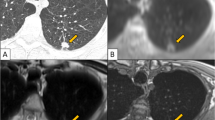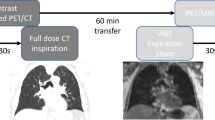Abstract
A FLASH technique was used, which encompassed the entire thorax in the transverse plane, before and after dynamic intravenous injection of godalinium DTPA (Gd-DTPA) to study 7 patients with normal lungs, 12 patients with interstitial lung disease (ILD), and 11 patients with pulmonary nodules. Comparative CT studies were obtained within 2 weeks of the MRI study in the patients with lung disease. Quantitative signal intensity (SI) measurements were performed. Qualitative evaluation of lung parenchyma was determined in a prospective blinded fashion, and in the normal group comparison was made with the CT images. In normal patients, SI of lung parenchyma increased by 7.7 ± 1.3%. On precontrast images, second-order pulmonary branchings were visible while post-contrast, fifth-to sixth-order branches were apparent. In patients with ILD, interstitial changes enhanced to a variable ] substantial (308.4%). Detection of pulmonary nodules improved following contrast injection. The minimum lesion size detectable decreased from 8 mm precontrast to 5 mm post-contrast. Percentage contrast enhancement was greater for malignant nodules (124.2 ±79.7%) than benign nodules (5.8 ± 4.7%)(p<0.01).
Society of North America, 1–6 December 1991, Chicago
Similar content being viewed by others
References
Naidich DP, Weinreb JC, Schinella R (1990) MR imaging of pulmonary parenchyma: comparison with CT in evaluating cadaveric lung specimens. J Comput Assist Tomogr 14: 595–599
Davis SD, Henschke CI, Yankelwitz DF, Cahill PT, YI Y (1990) MR imaging of pleural effusions. J Comput Assist Tomogr 14: 192–198
Musset D, Grenier P, Carette MF et al. (1986) Primary lung cancer staging: prospective comparative study of MR imaging with CT. Radiology 160: 607–611
Heelan RT, Demas BE, Caravelli JF et al. (1989) Superior sulcus tumors: CT and MR imaging. Radiology 170: 637–641
Webb WR, Gatsonis C, Zerhouni EA et al. (1991) CT and MR imaging in staging non-small cell bronchogenic carcinoma: report of the Radiologic Diagnostic Oncology Group. Radiology 178: 705–713
Doppman JL, Pass HI, Nieman LK et al. (1991) Detection of ACTH-producing bronchial carcinoid tumors: MR imaging vs CT. AJR 156: 39–43
Feuerstein IM, Jicha DL, Pass HI et al. (1992) Pulmonary metastases: MR imaging with surgical correlation. A prospective study. Radiology 182: 123–129
Glazer HS, Lee JKT, Levitt RG, Heiken JP, Ling D, Totty WG (1985) Radiation fibrosis: differentiation from recurrent tumor by MR imaging. Radiology 156: 721–726
McFadden RG, Carr TJ, Wood TE (1987) Proton magnetic resonance imaging to stage activity of interstitial lung disease. Chest 92: 31–39
Ehman RL, McNamara MT, Brasch RC, Felmlee JP, Gray JE, Higgins CB (1986) Influence of physiologic motion on the appearance of tissue in MR images. Radiology 159: 777–782
Kessler R, Fraisse P, Krause D, Veillon F, Vandevenne A (1991) Magnetic resonance imaging in the diagnosis of pulmonary infarction. Chest 99: 298–300
Rubin GD, Edwards DK III, Reicher MA, Doemeny JM, Carson SH (1989) Diagnosis of pulmonary hemosiderosis by MR imaging. AJR 152: 573–574
Bergin CJ, Glover GH, Pauly JM (1991) Lung parenchyma: magnetic susceptibility in MR imaging. Radiology 180: 845–848
Hatabu H, Gefter WB, Kressel HY, Axel L, Lenkinski RE (1989) Pulmonary vasculature: high resolution MR imaging. Work in progress. Radiology 171: 391–395
Littleton JT, Duriych ML, Moeller G, Herbert DE (1990) Pulmonary masses: contrast enhancement. Radiology 177: 861–871
Rubin GD, Steiner RM, Pelc NJ, Herfkens RJ et al. (1991) MR imaging of the pulmonary vasculature: optimization with a breath-holding spoiled gradient-echo technique. Radiology 181 (P): 156
Edelman RR, Siegel JB, Singer A, Dupuis K, Longmaid HE (1989) Dynamic MR imaging of the liver with Gd-DTPA: initial clinical results. AJR 153: 1213–1219
Swensen SJ, Morin RL, Schueler BA et al. (1992) Solitary pulmonary nodule: CT evaluation of enhancement with iodinated contrast material. A preliminary report. Radiology 182: 343–347
Bergin CJ, Pauly JM, Macovski A (1991) Lung parenchyma: projection reconstruction MR imaging. Radiology 179: 777–781
Author information
Authors and Affiliations
Additional information
Correspondence to: R. C. Semelka
Rights and permissions
About this article
Cite this article
Semelka, R.C., Maycher, B., Shoenut, J.P. et al. Dynamic Gd-DTPA enhanced breath-hold 1.5 t MRI of normal lungs and patients with interstitial lung disease and pulmonary nodules: preliminary results*. Eur. Radiol. 2, 576–582 (1992). https://doi.org/10.1007/BF00187555
Issue Date:
DOI: https://doi.org/10.1007/BF00187555




